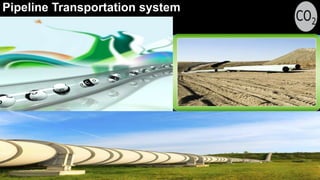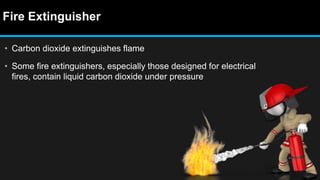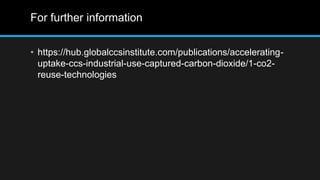Carbon dioxide capturing technology
- 3. Doctor of Nutrition and Diets • Muhammad Waqas • Whatsapp number 923058055403
- 4. Carbon Dioxide Processing of Carbon Dioxide
- 5. Contents • Carbon Dioxide • Properties • Dry Ice • Sources of Co2 • Introduction to Carbon Capture and Storage(CCS) • Co2 Transportation • Co2 Capturing Technologies • Co2 Storing • Advantages • Disadvantages
- 6. Carbon Dioxide • Carbon Dioxide is natural gas • It is present in air at very low level 0.03% by volume • It vital substance to plant kingdom for the process of photosynthesis • Carbon Dioxide can exist in three forms: Gas Solid (dry ice) Liquid (under certain pressure level) O O C
- 9. Properties • Non-toxic, colorless and odorless gas that does not impart any flavor to the beverage • Nonflammable and no fire hazards when handling • Soluble in water and dissolves easily in the beverages • Its solubility can be controlled by regulating the temperature and pressure • In water , it forms a weak acid(carbonic acid) • The carbonic acid can retard the growth of microorganisms • Carbonic acid easily releases Co2 gas to create effervescence
- 10. Dry Ice • Dry ice is the solid form of carbon dioxide • It is used primarily as a cooling agent • Its temperature is lower than water ice • It is useful for preserving frozen foods where mechanical cooling is unavailable
- 11. Sources of Co2 • By burning of carbonaceous materials C + O2 Co2 • In the production of H2 by steam reforming of methane or other hydrocarbons, 16% pure Co2 is obtain CH4 + 2H2O Co2 + 4H2 • In manufacture of alcohol (ethanol) by the fermentation process 99.9 % pure CO2 is obtained C6H12O6 C2H5OH + Co2 • In calcinations of CaCo3 at 1000°C ,40% Co2 is obtained CaCo3 CaO + Co2
- 12. CO2 Capturing & Storing process
- 13. Carbon Capture & Storage Technology • “A Technology that can capture 90% of the Carbon Dioxide Emission and Prevent Co2 from entering the Atmosphere” • The CCS chain consist of three parts 1. Capturing 2. Transportation 3. Storage
- 14. Capturing Carbon Dioxide • Capturing of Co2 by o Pre Combustion Technology o Post Combustion Technology o Oxy Fuel Process
- 15. Pre Combustion Technology • Removing Co2 before combustion • By Gasifying the coal through the reaction with oxygen(O2) • It is possible to obtain a mixture of mostly Co2 & H2 • Co2 is captured and H2 is use as fuel
- 16. Post Combustion Technology • Removing Co2 after combustion • Applicable to fossil fuel burning power plants that release fuel gas • Reacting the fuel gas with chemicals that absorb Co2 and then heat the chemicals to release Co2 • Fuel Gas “Mixture of Nitrogen , water vapor , 15% Co2
- 17. Oxy Fuel Process • The Fuel is burnt in oxygen(O2) instead of air • The resultant flue gas is condensed through cooling • Resultant is an pure Co2 stream
- 18. Overview of Co2 Capture
- 19. Transport of Co2 • Co2 is transported in three states: o Gas o Liquid o Solid • Transportation system used: o Pipeline Transportation system o Marine Transportation system
- 22. Storage options • Geological storage • Oceanic storage • Mineral storage
- 23. Geological storage • Storing carbon dioxide under earth's surface is called geo- sequestration • Injecting Co2 into: • Underground geological formations • Oil fields • Saline formations
- 25. Oceanic storage • Dissolving Co2 at mid depths • Injecting Co2 at depths exceeding 3km where it would form lakes of liquid Co2 • Below 3km where depth • Liquid Co2 will be denser than sea water and will sink to the ocean floor
- 26. Mineral Storage • Co2 is reacted with mineral to form Carbonates
- 27. MAJOR STORAGE SITES IN THE WORLD • Sleipner, Norwegian North Sea • Altmark, Germany • Weyburn, Canada • In Salah, Algeria • Miranga, Brazil • Hontomin, Spain • Hastings, Texas, USA
- 28. Advantages • Reduces pollution • Reduces changes in atmospheric temperature • Enhanced oil recovery
- 29. Disadvantages • Leakage problems may occur • Costly process • Damage pipelines • Oceanic Acidification
- 30. Conclusion • CCS involves capturing millions of tones of Co2 a year from gas or coal • Valuable tool in the fight against climatic change
- 31. Uses of Co2 Carbon dioxide is a food additive used as a propellant and acidity regulator in the food industry It is approved for usage in the EU, USA, Australia and New Zealand Food
- 32. Baking • Leavening agents cause dough to rise by producing carbon dioxide • yeast produces carbon dioxide by fermentation of sugars within the dough, while chemical leaveners such as baking powder and baking soda release carbon dioxide when heated or if exposed to acids
- 33. Beverages Carbonation • Carbon dioxide is used to produce carbonated soft drinks and soda water • Traditionally, the carbonation in beer and sparkling wine came about through natural fermentation, but many manufacturers carbonate these drinks with carbon dioxide recovered from the fermentation process • In the case of bottled and kegged beer, the most common method used is carbonation with recycled carbon dioxide
- 35. Wine Making • CO2 is used as a seal gas to prevent oxidation of the wine during maturation • The main advantage of using dry ice over regular water ice is that, • It cools the grapes without adding any additional water that may decrease the sugar concentration in the grape • Therefore also decrease the alcohol concentration in the finished wine.
- 36. Cont... • Co2 is also produced during the fermentation process • It is already captured on-site for reuse for its inert gas properties
- 37. Coffee Decaffeination • Supercritical Co2 is used as the solvent for decaffeinating coffee • It is preferred due to its inert and non-toxic properties.
- 38. Welding & Metal Fabrication • Carbon dioxide is most often mixed with argon as a shielding gas • Used to prevent atmospheric contamination of molten metal in electric arc welding processes
- 39. Fire Extinguisher • Carbon dioxide extinguishes flame • Some fire extinguishers, especially those designed for electrical fires, contain liquid carbon dioxide under pressure
- 40. Food processing, preservation and packaging • Co2 is used for various applications in the food industry • Carbon dioxide is commonly used in MAP and CAP because of its ability to inhibit growth of bacteria that cause spoilage • In packaging applications, Co2 is used in MAP&CAP with products such as cheese, poultry, snacks, produce and red meat etc. • Including cooling while grinding powders such as spices and as an inert atmosphere to prevent food spoilage
- 41. Supercritical CO2 as solvent • Liquid carbon dioxide is a good solvent for many lipophilic organic compounds • It is used to remove caffeine from coffee • Other chemical processing industries as a less toxic alternative to more traditional solvents such as oraganochlorides • https://thetakeout.com/how-do-you-remove-caffeine- from-coffee- 1798252806?utm_medium=sharefromsite&utm_source= thetakeout_copy&utm_campaign=top
- 42. Pulp and paper processing • CO2 is used to reduce pH during pulp washing operations.
- 43. Pharmaceutical • Use of CO2 in the pharmaceutical industry typically includes • Inerting • Chemical synthesis • Supercritical fluid extraction • Product transportation at low temperature • Acidification of wastewater
- 44. Enhanced oil recovery (EOR) • Co2 is injected into depleted oil fields • The Co2 acts as a solvent that reduces the viscosity of the oil, enabling it to flow to the production well • Once production is complete, the Co2 can potentially be permanently stored in the reservoir
- 45. Horticulture • Co2 is provided to greenhouses to maintain optimal Co2 concentration and maximize plant growth rate • Sources include on-site cogeneration schemes as well as off-site industrial sources connected via pipeline networks
- 46. References Gibbins, J., Chalmers, H. (2007). Preparing for global rollout: A ‘developed country first’ demonstration programme for rapid CCS deployment. Energy Policy. doi:10.1016/j.enol.2007.10.021. Tzimas, T., Mercier, A., Cormos, C. and Petevas, S.D. (2007). Trade-off in emissions of acid gas pollutants and of carbon dioxide in fossil fuel power plants with carbon capture. Energy Policy. 35 (8):3991-3998. Bickle, M., Chadwick, A., Huppert, H. E., et al. (2007). Modelling carbon dioxide accumulation at Sleipner: Implications for underground carbon storage. Earth and Planetary Science. 255, 164–176. Johansson, M., Mattisson, T., Lyngfelt, A. et al. (2008). Using continuous and pulse experiments to compare two promising nickelbased oxygen carriers for use in chemicallooping technologies. Fuel. 87 :988-1001. Race, J.M., Seevam, P. N., Downie, M.J. (2007). Challenges for offshore transport of anthropogenic carbon dioxide. Proceedings of OMEA2007, 10-15 June, 2007, San Diego, CA,USA.
- 47. For further information • https://hub.globalccsinstitute.com/publications/accelerating- uptake-ccs-industrial-use-captured-carbon-dioxide/1-co2- reuse-technologies
- 48. Muhammad Waqas















































